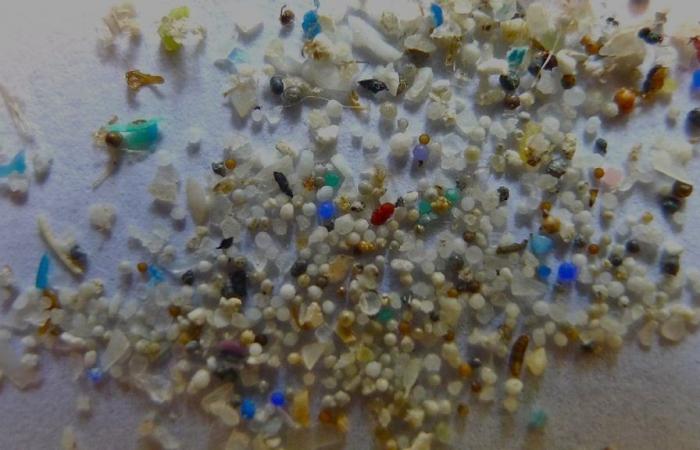Study links microplastics to human health problems
BY MARK PATRICK TAYLOR AND SCOTT P. WILSON
A recent study published in the prestigious journal New England Journal of Medicine
linked microplastics to a risk to human health.
The study involved patients in Italy who had a condition called carotid artery atheroma plaque, meaning plaque builds up in the arteries, potentially blocking blood flow. The researchers analyzed plaque samples from these patients.
They found that those with carotid artery plaque who had microplastics and nanoplastics suffered a higher risk of heart attack, stroke or death, compared to patients with carotid artery plaque who had no micro- or nanoplastics detected in their plaque samples.
Importantly, the researchers did not find that micro- and nanoplastics caused the greatest risk, only that it was correlated with it.
So what should we make of these new discoveries? And how do they fit with the broader evidence about microplastics in our environment and in our bodies?
What are microplastics?
Microplastics are plastic particles less than 5 millimeters in diameter. Nanoplastics are less than 1 micron in size (1,000 microns equal 1 millimeter). Precise size classifications are still a matter of debate.
Microplastics and nanoplastics are created when everyday products – including clothing, food and drink packaging, furniture, plastic bags, toys and hygiene products – degrade. Many personal care products contain microplastics in the form of microbeads.
Plastic is also widely used in agriculture and can degrade over time into microplastics and nanoplastics.
These particles are composed of common polymers such as polyethylene, polypropylene, polystyrene and polyvinyl chloride. The chemical constituent of polyvinyl chloride, vinyl chloride, is considered carcinogenic by the United States Environmental Protection Agency.
Of course, the actual risk of harm depends on your level of exposure. As toxicologists often say, it’s the dose that makes the poison, so we need to be careful not to overinterpret emerging research.
A closer look at the study
This new study in New England Journal of Medicine
was carried out with a small group, initially composed of 304 patients. However, only 257 completed the follow-up portion of the study 34 months later.
The study had several limitations. The first is that the results only related to asymptomatic patients who underwent carotid endarterectomy (a procedure to remove plaque from the carotid artery). This means that the results may not be applicable to the general population.
The authors also point out that while exposure to microplastics and nanoplastics has likely increased in recent decades, rates of heart disease have been decreasing.
That said, the fact that so many people in the study had detectable levels of microplastics in their bodies is remarkable. The researchers found detectable levels of polyethylene and polyvinyl chloride (two types of plastic) in carotid plaque excised from 58% and 12% of patients, respectively.
These patients were more likely to be younger men with diabetes or heart disease and a history of smoking. There was no substantive difference in the location of the patients.
Markers of inflammation in plaque samples were higher in patients with detectable levels of microplastics and nanoplastics compared to those without.
And then there’s the key finding: Patients with microplastics and nanoplastics in their plaque had a higher risk of having what doctors call a “primary endpoint event” (nonfatal heart attack, nonfatal stroke, or death from any cause) than those who did not have microplastics and nanoplastics in their plaque.
The study authors note that their results “do not prove causality.”
However, it would be remiss not to be cautious. The history of environmental health is replete with examples of substances initially considered suspect that have avoided adequate regulation due to what the U.S. National Research Council refers to as “assuming untested chemicals.” This assumption arises when there is no research demonstrating adverse effects, which makes regulatory action unnecessary.
In general, more research is needed to find out whether microplastics cause harm to human health. Until such evidence exists, we must adopt the precautionary principle. The absence of evidence should not be considered as evidence of absence.
Global and local action
Exposure to microplastics in our home, work and outdoor environments is inevitable. Governments around the world have begun to recognize that we must intervene.
The Global Plastics Treaty will be enacted by 175 nations starting in 2025. It is designed, among other things, to limit global exposure to microplastics. The burdens are greatest especially on children and particularly those from low- and middle-income nations.
In Australia, legislation ending single-use plastics will help. Likewise, expanding container deposit schemes that include plastic bottles will also contribute.
Microplastic pollution is an area that requires a collaborative approach between researchers, civil societies, industry and government. We believe that the formation of a “national microplastics council” would help formulate and coordinate strategies to address this problem.
Little things matter. Small actions by individuals can also translate into significant overall environmental and human health benefits.
Choosing natural materials, fabrics and utensils that are not made from plastic and disposing of waste carefully and appropriately – including recycling whenever possible – is helpful.
Mark Patrick Taylor – Chief Environmental Scientist, EPA Victoria; Honorary Professor in the School of Natural Sciences, Macquarie University, Australia.
Scott P. Wilson – Research Director of the Australian Microplastics Assessment Project (AUSMAP); Honorary Senior Research Fellow in the School of Natural Sciences, Macquarie University, Australia.
This text was republished from
The Conversation
under a Creative Commons license.
Read the original article.
Read more ESG Insights articles.
Photo: “Microplastic” by Oregon State University is licensed under CC BY-SA 2.0.
LATEST NEWS
-
Study links microplastics to human health problems
April 25, 2024Microplastic is present in clothing, furniture, hygiene products, packaging and in agriculture
-
UN initiative seeks to increase respect for human rights in companies
April 24, 2024The tool is free, available now and participation is voluntary; The expectation is that it will reach at least 500 companies
-
Young apprentice: country employs much less than predicted by law
April 24, 2024Created to combat school dropout, child labor and unemployment, the Learning Law is on companies’ ESG radar
-
CPI will investigate payments with Braskem compensation money
April 23, 2024President of the CPI, senator Omar Aziz, says it is necessary to investigate the purchase of a hospital by the city hall with compensation money
-
The invisible cost of work for famous clothing brands in Thailand
April 23, 2024Abusive working hours, low pay and negligence; read the story of a worker
-
Climate change affects the health of 70% of workers worldwide
April 22, 2024Study shows that more than 2.4 billion people may be exposed to excessive heat during work
-
How coffee and cocoa producers deal with climate change
April 22, 2024Meeting of Rural Leaders, in Costa Rica, brings different experiences and perspectives to the climate future
-
ESG Agenda: courses and events of the week – 4/22
April 22, 2024New programming related to ESG themes
-
ESG week summary: plastic in the oceans, ISO and ESG standards, climate change
April 19, 2024Topics that were highlighted during ESG Insights week
-
Future fuels and the carbon market are on the agenda in the Senate
April 19, 2024The idea is to create standards that attract investments and an energy transition adapted to the context of climate change
The post Study links microplastics to human health problems appeared first on ESG Insights.






